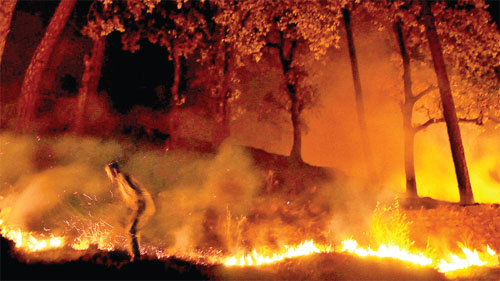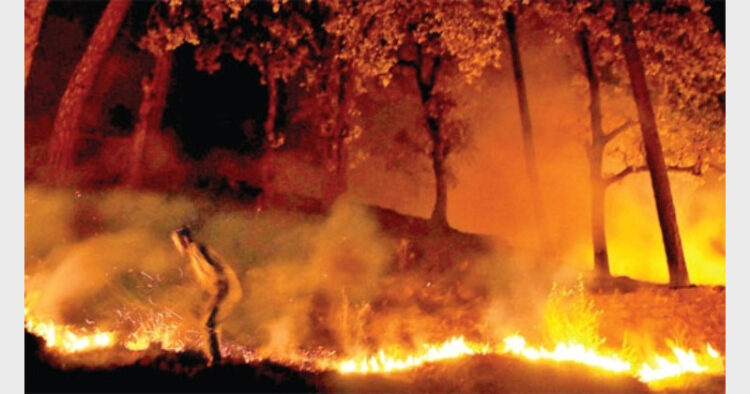 Virendra Painuly
Virendra Painuly
The forests of Uttarakhand are in the severe grip of dense smoke. The heat and sparks generating from the sky-high flames of burning trees continue to touch the adjoining states of Himachal Pradesh and Jammu & Kashmir also. But the local people of Uttarakhand are visualising more incendiary scenes than these flames. Their heart cry more when they see the tourists visiting Dehradun, Rishikesh, Mussoorie and other places sharing the stories of burning forests with excitement and thrill. It is grossly unpardonable act of human stupidity and administrative lethargy for the Himalayas, which today finds itself in the clutch of smoke, heat, stuffiness and helplessness. The heated stones are sliding from burning forests near Nainital posing grave threat to the security of tourists visiting there and the locals. There is fear in villages also.
The fire in the Himalayan region and also in the forests anywhere in the country is normally treated as routine incidents during summers. The period from February 15 to June 15 is apprehended full of such incidents. The alertness of the forest department too is normally maintained according to this calendar. Eight villagers had sacrificed their lives, while controlling the forest fire at Gagvadasyun under Pauri Tehsil on May 1, 2009. This fact was also recorded by the forest department. It is a well known fact in hilly areas that the forest fire, which spread in thousands of hectare land, is put off either by the rains or through the efforts of local people. This is the reason when the first news of fire in forests of Uttarakhand was reported on February 2 the local administration as well as the forest department took it lightly. The minor incidents reported from hundreds of places gradually assumed the gigantic form and within the last three months it spread in 13 districts ruining over 2,270 hectares of forest land.
Five incidents in NutshellAbout 2,000 acre area of Uttarakhand, which has more than 12,000 Forest Panchayats, is in the grip of drought and witnessing high temperature. The fire not only damaged innumerable forest wealth, but also damaged the huge quantity of widely used herbs and drugs like Salam Panja, Kutaki, Atis, Koot and Jwar, etc. This will adversely affect the production of many highly useful Ayurvedic medicines Pirul, which spreads seeds of pine trees, is highly inflammable. When the burning Piruls roll over the rocks they spread fire speedily. About 3 crore tonnes of Pirul had got stored in the forests of Uttarakahand during the last four years and there was no sincere effort to clean that. Bio fuel and electricity can be generated from Pirul. On many occasions, some plans were formulated by different government agencies for it, but they were not implemented due to lack of will power resulting in the wealth, the cause of destruction The forests of Uttarakhand reported big fires during the year 1992, 1997, 2004, 2008 and 2012. The fire this time has ruined the forest sprawling in about 4,000 hectares. About half a dozen people have died and over a dozen received burn injuries in more than 1,600 incidents of fire reported from 13 districts. The fire did not leave any region whether Garhwal, Kumanyun, Bhabar-Tarai, hills or planes. About 70 hectare forest area in Rajaji National Park situated in Haridwar, 60 acre area of Kidarnath Deer Sanctuary and 200 acre area of Corbbet National Park have been ruined by the fire. Khirsu, Pokhari and Yamakeshwar in Pauri, Karnaprayag, Tharali and Dasholi in Chamoli, Jakholi in Rudraprayag, Vinsar and Dhaula Devidhura in Almora have been hugely affected in this year’s fire |
The causes of the fire are mixed. The rains during the last two monsoon seasons have been even below the average. The rains during winter also were very low. In this situation, the scorching heat witnessed in March, proved to be disastrous. Hence, the fire which began from the bushes spread in the big area. The large number of pine trees found in the central Himalayas at low height also added fuel to the fire. The mutual rubbing of pine trees also generates fire.
During the last two months the entire Uttarakhand has turned into a gas chamber due to this fire. It is for the first time in the history of Uttarakhand that helicopters have been used to control the fire. The teams of Indian Army, Air Force and NDRF were deployed on war footing to arrest the spread of the fire. Till the time of writing this report, about 6,000 people including 135 NDRF men and 4,500 forest personnel were engaged to curb the fire. This is a fact that the forest fire cannot be curbed by merely spraying water through helicopters. The environmentalists feel the immediate need to reconnect local people with the forest and also to revive the natural ponds in forests as a permanent solution. Apart from it the accountability of Van Mitras, forest personnel and forest offices should also be fixed.
Centre joins fire fighting Union Environment Minister Prakash Javadekar said the Centre is taking the forest fires in Uttarakhand “very seriously” and making all efforts to control it even as his Ministry began trial runs for a pre-fire alert system that would issue warnings via SMS. “The Government is taking the forest fires of Uttarakhand very seriously. 6,000 people have been deployed for fighting it. We also granted Rs 5 crore to the State. Our top officer, including the DG of Forest Department is on the spot guiding the local forces. The Air Force, the Home Ministry…all are helping and guiding the residents there,” he said. |
The forest mafias, animal smugglers and also those engaged in illegal trade of herbs have also been seen involved in forest fires to cover their illegal activities. But such a gigantic form of the fire cannot be blamed only due to the smugglers. Others too are responsible. Though, the Climate Change Action Plan with the budget of hundreds of crore has been implemented in the State, it was strongly opposed by over 144 organisations in 2013 because it does not include the traditional knowledge and the public complaints. The people had also criticised its over bureaucratisation.
As per the latest available Forest Survey of India report, 24,992 sq km of land mass (46.73% of total) is covered by forests and trees. Important to note here is that Uttarakhand — 1.627% of India’s total land mass — is home to 3.15% of total forest cover of the country. Of the total forest cover, 19,889 sq kms of forest is a one single patch while there are approximately 11,354 patches of forests within 0.01 to 10 sq kms category- corresponding number for 10-100 sq kms, 100-500 sq kms and 500-1,000 sq kms is 42, 6 and 1 respectively.
The experts feel that overcoming the loss caused by the fire is impossible. It has not only caused huge damage to the forests adversely affecting productivity of agriculture, quality of soil and annual growth of the forests, but also laid the foundation of possible natural calamities in the form of landslides. The experts accept that the heat generated by the fire for three months may prove to be highly adverse for the health of local people. It may also further lead to the untimely melting of many glaciers in Uttarakhand. Some of such glaciers include Gangotri, Milam, Sunder Dunga, Nevla and Cheepa. The impact of this heat was also recently realised in the sudden growth of temperature upto 9.2 Degree Celsius in northern India. It is apprehended that the growing heat may also adversely impact the monsoon.
What is the Solution
Involvement of local people in protection of forests should be increased and they should be allowed entry into the forests. They play more effective role in keeping a vigil on the illegal activities normally going on in the forests. Curbing the fire by spraying water through helicopters is no solution. The natural resources existed in the forests should be revived so that sufficient water stores there during the rains and the forest animals face no water scarcity during the summers. Efforts should be made to grow mixed forests, because the types of trees which are being promoted today are prone to fire.
(The writer is a social activist and environment scientist)













Comments